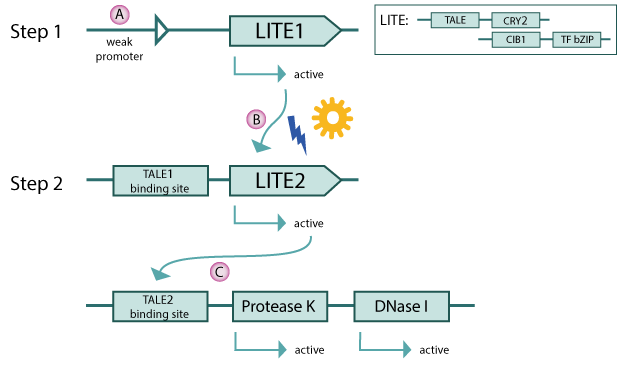Team:Marburg/Safety
From 2013.igem.org
| Line 7: | Line 7: | ||
[[File:safety_mr2.png|600px|center]] | [[File:safety_mr2.png|600px|center]] | ||
| - | <center>Figure 1: LITE leads to expression of Protease K and DNaseI. | + | <center>Figure 1: LITE leads to expression of Protease K and DNaseI. |
| + | A) A weak promotor leads to the low expression of the first LITE module. | ||
| + | B) Upon illumination with blue light the conformational change of CRY2 activates the LITE module, which binds to a specific region upstream of the second LITE module. | ||
| + | C) The active second LITE module leads to the expression of Protease K and DNAseI.</center> | ||
To minimize the uninduced activation of the security system we engineered a two-stage system. The main component is the LITE (light-inducible transcriptional effectors) module. It consists of a transcription activator -like effector (TALE) fused to a blue light sensitive cryptochrome 2 protein (CRY2). Upon blue light reception the conformational change of CRY2 recruits the CIB1 interaction partner, fused to an effector (e.g. transcription factor of the bZIP family). This effector recruits the transcription complex resulting in transcription and expression of the desired gene. | To minimize the uninduced activation of the security system we engineered a two-stage system. The main component is the LITE (light-inducible transcriptional effectors) module. It consists of a transcription activator -like effector (TALE) fused to a blue light sensitive cryptochrome 2 protein (CRY2). Upon blue light reception the conformational change of CRY2 recruits the CIB1 interaction partner, fused to an effector (e.g. transcription factor of the bZIP family). This effector recruits the transcription complex resulting in transcription and expression of the desired gene. | ||
Revision as of 23:49, 21 September 2013
Phaectory: Red or dead
The work with genetically modified organisms (GMOs) harbours the risk of their release to the nature. After release, serious consequences such as gene exchange with unmodified organism or ecosystem imbalance cannot be excluded. It is necessary to keep GMOs isolated from the environment or to make their survival in nature impossible. Therefore, we decided to develop a security system for Phaeodactylum tricornutum. Based on the publication of Konermann et al. 2013, we designed a system that leads to cell death induced by blue light.
A) A weak promotor leads to the low expression of the first LITE module. B) Upon illumination with blue light the conformational change of CRY2 activates the LITE module, which binds to a specific region upstream of the second LITE module.
C) The active second LITE module leads to the expression of Protease K and DNAseI.To minimize the uninduced activation of the security system we engineered a two-stage system. The main component is the LITE (light-inducible transcriptional effectors) module. It consists of a transcription activator -like effector (TALE) fused to a blue light sensitive cryptochrome 2 protein (CRY2). Upon blue light reception the conformational change of CRY2 recruits the CIB1 interaction partner, fused to an effector (e.g. transcription factor of the bZIP family). This effector recruits the transcription complex resulting in transcription and expression of the desired gene. In the first stage a LITE module is under the control of a weak, constitutive promotor resulting in a constant low level of LITE1 in the cell. The TALE and the attached CRY2 bind to the TALE1 binding site upstream of the LITE2 module. LITE1 stays inactive until illumination with blue light. When blue light activates CRY2 the LITE1 module assembles resulting in the expression of LITE2. LITE2 in turn binds to the TALE binding site 2 leading to the expression of Protease K and DNaseI. Protease K is a potent protease with a broad substrate specificity working even at low temperature. DNaseI digests single- and double- stranded DNA efficiently. Beside instant activation of a light inducible system the major advantage in our approach is the prevention of additional chemical compounds in the medium resulting in unnecessary purification steps for the secreted antibodies.
For the technical realization we suggest a blue light filter for Phaectory. In the unlikely event of an algae outbreak from isolation, the existing blue spectrum of the sunlight will lead to the immediate activation of the LITE security system and the inevitable death of P. tricornutum (Figure 2).
 "
"






